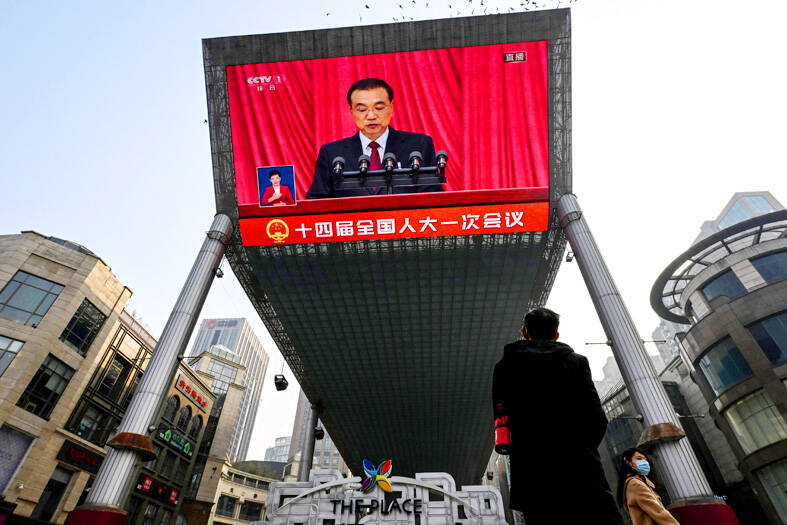China said its defense spending would grow by 7.2 percent this year — the fastest pace since 2019 amid increasing tensions with the US on a range of issues, including Taiwan.
The increase in the world’s second-largest defense budget came as Beijing announced an economic growth goal of about 5 percent for this year — one of its lowest in decades.
Military expenditure is expected to rise to 1.55 trillion yuan (US$224.4 billion) this year, according to the Chinese Ministry of Finance’s annual report released yesterday at the start of the Chinese National People’s Congress in Beijing.

Photo: AFP
It officially rose 7.1 percent last year.
Spending on China’s People’s Liberation Army (PLA) has increased by at least 6.6 percent each year for the past three decades, keeping pace or often exceeding economic growth.
Outgoing Chinese Premier Li Keqiang (李克強) told congress delegates that “external attempts to suppress and contain China are escalating.”
“The armed forces should intensify military training and preparedness across the board,” he said as he presented the government’s annual work report to thousands of amassed delegates in Beijing’s Great Hall of the People.
The military must “devote greater energy to training under combat conditions, and ... strengthen military work in all directions and domains,” he added.
China’s defense spending still pales in comparison with the US, which has allotted more than US$800 billion for its military this year.
The defense figure that China unveils every year is among the few official announcements that offer signs of progress the PLA is making in its revamp.
Analysts outside the nation say the actual amount far exceeds the official sum, partly because research and development expenditures are not included.
This year’s figure “feels in part a reflection of the growing increase in military spending we see globally and regionally, while also a reflection of increased sense of threat in Beijing and a need to be prepared for eventualities,” said Raffaello Pantucci, a senior fellow at the S. Rajaratnam School of International Studies in Singapore.
“Taiwan will clearly be seen as an important focus, but my view would be that Chinese preparations go farther than this and remain about building a globally competitive military,” Pantucci said.
Yesterday’s conservative economic goals followed China posting just 3 percent growth last year, widely missing its 5.5 percent target as the economy strained under the effects of strict COVID-19 containment policies and a property crisis.
Li struck a bullish tone in his speech, saying that China’s economy “is staging a steady recovery and demonstrating vast potential and momentum for further growth.”
The sustained growth in defense spending despite sagging economic expectations showed that “security is now much more important for the national leadership” than before, said Alfred Muluan Wu (吳木鑾), an associate professor at the University of Singapore’s Lee Kuan Yew School of Public Policy.
“It is even, to some extent, more important than economic growth,” he said.
China also plans to increase its public security budget by 6.4 percent — the fastest pace in five years. That rise comes after the Asian nation experienced its most widespread protests in decades in November last year due to broad discontent over harsh COVID-19 regulations.

TRAGEDY STRIKES TAIPEI: The suspect died after falling off a building after he threw smoke grenades into Taipei Main Station and went on a killing spree in Zhongshan A 27-year-old suspect allegedly threw smoke grenades in Taipei Main Station and then proceeded to Zhongshan MRT Station in a random killing spree that resulted in the death of the suspect and two other civilians, and seven injured, including one in critical condition, as of press time last night. The suspect, identified as a man surnamed Chang Wen (張文), allegedly began the attack at Taipei Main Station, the Taipei Fire Department said, adding that it received a report at 5:24pm that smoke grenades had been thrown in the station. One man in his 50s was rushed to hospital after a cardiac arrest

A car bomb killed a senior Russian general in southern Moscow yesterday morning, the latest high-profile army figure to be blown up in a blast that came just hours after Russian and Ukrainian delegates held separate talks in Miami on a plan to end the war. Kyiv has not commented on the incident, but Russian investigators said they were probing whether the blast was “linked” to “Ukrainian special forces.” The attack was similar to other assassinations of generals and pro-war figures that have either been claimed, or are widely believed to have been orchestrated, by Ukraine. Russian Lieutenant General Fanil Sarvarov, 56, head

SAFETY FIRST: Double the number of police were deployed at the Taipei Marathon, while other cities released plans to bolster public event safety Authorities across Taiwan have stepped up security measures ahead of Christmas and New Year events, following a knife and smoke bomb attack in Taipei on Friday that left four people dead and 11 injured. In a bid to prevent potential copycat incidents, police deployments have been expanded for large gatherings, transport hubs, and other crowded public spaces, according to official statements from police and city authorities. Taipei Mayor Chiang Wan-an (蔣萬安) said the city has “comprehensively raised security readiness” in crowded areas, increased police deployments with armed officers, and intensified patrols during weekends and nighttime hours. For large-scale events, security checkpoints and explosives

PUBLIC SAFETY: The premier said that security would be tightened in transport hubs, while President Lai commended the public for their bravery The government is to deploy more police, including rapid response units, in crowded public areas to ensure a swift response to any threats, President William Lai (賴清德) said yesterday after a knife attack killed three people and injured 11 in Taipei the previous day. Lai made the remarks following a briefing by the National Police Agency on the progress of the investigation, saying that the attack underscored the importance of cooperation in public security between the central and local governments. The attack unfolded in the early evening on Friday around Taipei Main Station’s M7 exit and later near the Taipei MRT’s Zhongshan